INSTITUT SUPERIEUR D'ANTHROPOLOGIE
INSTITUTE OF ANTHROPOLOGY
ONLINE COURSES / COURS A DISTANCE
WINTER TERM : JANUARY 2014
REGISTER NOW
JAPON – 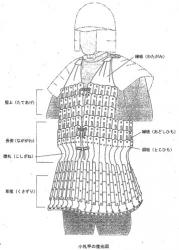
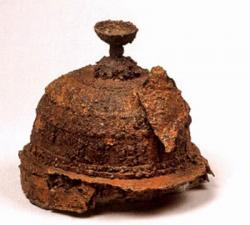 Kanai-Higashiura - The Gunma Prefectural Board of Education and Gunma Archaeological Research Foundation, investigating the bones of a man from the Kofun period (ca 300-ca 710) dressed in armor found in the prefecture in November last year, have announced they have also found a helmet near his facial bones. The presence of the iron helmet was confirmed beneath the man’s facial bones in a computer tomography scan, according to Toshiyuki Uchiyama, section chief of the excavation division of the Tochigi Miraizukuri Foundation’s Archaeological Research Center. The man’s bones, covered by armor, were found at the Kanai-Higashiura archaeological site November last year in Shibukawa, Gunma Prefecture. The helmet is thought to belong to the same man. “It is highly possible that this is a helmet that was actually used during the Kofun period, the first ever confirmed in the country,” Uchiyama said. Although similar helmets have already been found in ancient tombs of the mid- to late-Kofun period, they were all made for ritual or ornamental purposes, such as burials. Therefore, it will be the first helmet that was functionally used if it can be confirmed that it was worn. A CT scan of the soil covering the skull showed the 13-centimeter high helmet, which is 25 centimeters by 20 centimeters, according to the organizations. The shikoro, the part for covering the back of the head and neck, remains in the helmet. It also has hoate cheek protectors. Like the armor, which was found last year, the helmet is made with kozane metal scales. “The helmet and the armor are highly likely to be a set of defense tools. The man wearing them might have been the most powerful person in the area,” Uchiyama added.
Kanai-Higashiura - The Gunma Prefectural Board of Education and Gunma Archaeological Research Foundation, investigating the bones of a man from the Kofun period (ca 300-ca 710) dressed in armor found in the prefecture in November last year, have announced they have also found a helmet near his facial bones. The presence of the iron helmet was confirmed beneath the man’s facial bones in a computer tomography scan, according to Toshiyuki Uchiyama, section chief of the excavation division of the Tochigi Miraizukuri Foundation’s Archaeological Research Center. The man’s bones, covered by armor, were found at the Kanai-Higashiura archaeological site November last year in Shibukawa, Gunma Prefecture. The helmet is thought to belong to the same man. “It is highly possible that this is a helmet that was actually used during the Kofun period, the first ever confirmed in the country,” Uchiyama said. Although similar helmets have already been found in ancient tombs of the mid- to late-Kofun period, they were all made for ritual or ornamental purposes, such as burials. Therefore, it will be the first helmet that was functionally used if it can be confirmed that it was worn. A CT scan of the soil covering the skull showed the 13-centimeter high helmet, which is 25 centimeters by 20 centimeters, according to the organizations. The shikoro, the part for covering the back of the head and neck, remains in the helmet. It also has hoate cheek protectors. Like the armor, which was found last year, the helmet is made with kozane metal scales. “The helmet and the armor are highly likely to be a set of defense tools. The man wearing them might have been the most powerful person in the area,” Uchiyama added.
http://the-japan-news.com/news/article/0000771731
ROYAUME UNI – 
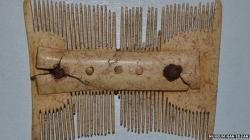 Udal - All artefacts from a site where evidence has been found for every age from the Neolithic to the 20th Century are to be kept on the Western Isles. Archaeology at Udal provides an "unbroken timeline" of occupation from the Neolithic, Bronze Age, Iron Age, Viking, Medieval through to the 1900s. Some of the evidence at the site was preserved by wind-blown sand dunes. Under the terms of a new agreement, the artefacts have been allocated to Museum nan Eilean in Stornoway on Lewis. Comhairle nan Eilean Siar had asked the Scottish Archaeology Finds Allocations Panel for the material recovered from the site on North Uist be kept on the Western Isles. The items include human remains, ancient bone combs and pottery. They were found during excavations led by archaeologist Ian Crawford between 1963 and 1995. The earliest Neolithic layers he revealed consisted of a line of stones with a large upright stone nicknamed the great auk stone because of its resemblance to the extinct seabird. A deep shaft containing quartz pebbles which had been covered over with a whale's vertebrae was also uncovered. From the Bronze Age, finds included a skeleton and from the Iron Age evidence of metal work. Also, from the Iron Age were the remains of homes dubbed Jelly Baby houses because the shape of them looked like the sweets. Evidence of a Viking longhouse and later occupation during the 1600s through to the 18th and 19th Centuries were also found. From the early 20th Century was a saw pit for cutting up wrecked boats.
Udal - All artefacts from a site where evidence has been found for every age from the Neolithic to the 20th Century are to be kept on the Western Isles. Archaeology at Udal provides an "unbroken timeline" of occupation from the Neolithic, Bronze Age, Iron Age, Viking, Medieval through to the 1900s. Some of the evidence at the site was preserved by wind-blown sand dunes. Under the terms of a new agreement, the artefacts have been allocated to Museum nan Eilean in Stornoway on Lewis. Comhairle nan Eilean Siar had asked the Scottish Archaeology Finds Allocations Panel for the material recovered from the site on North Uist be kept on the Western Isles. The items include human remains, ancient bone combs and pottery. They were found during excavations led by archaeologist Ian Crawford between 1963 and 1995. The earliest Neolithic layers he revealed consisted of a line of stones with a large upright stone nicknamed the great auk stone because of its resemblance to the extinct seabird. A deep shaft containing quartz pebbles which had been covered over with a whale's vertebrae was also uncovered. From the Bronze Age, finds included a skeleton and from the Iron Age evidence of metal work. Also, from the Iron Age were the remains of homes dubbed Jelly Baby houses because the shape of them looked like the sweets. Evidence of a Viking longhouse and later occupation during the 1600s through to the 18th and 19th Centuries were also found. From the early 20th Century was a saw pit for cutting up wrecked boats.
http://www.bbc.co.uk/news/uk-scotland-highlands-islands-24840147
ROYAUME UNI – 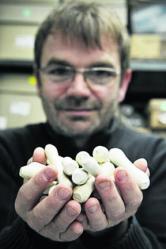 Oxford - Oxford Archaeology’s work at Oxford University’s Magdalen College has uncovered an intriguing tale of fashion and academia as part of building a new library. More than 3,500 wig curlers were found in the High Street college’s quad, which senior projects manager Ben Ford researched back to a barber, John Broughton, who leased a tenement at the site. Staff discovered a small, stone-walled basement with the curlers, a cut-throat razor, a deer-horn handled knife and wine bottles from the common room with a 1769 date stamp. Remarkably, some of the curlers were imprinted with news or book print that was wrapped around them before being put in the oven with a wig to expand in the heat. Though wigs were going out of fashion towards the end of the century, former college president Dr Martin Routh was a known aficionado, he said. Mr Foster said: “You have a snapshot in time. This is a rare find. You can make the links because records survive.”
Oxford - Oxford Archaeology’s work at Oxford University’s Magdalen College has uncovered an intriguing tale of fashion and academia as part of building a new library. More than 3,500 wig curlers were found in the High Street college’s quad, which senior projects manager Ben Ford researched back to a barber, John Broughton, who leased a tenement at the site. Staff discovered a small, stone-walled basement with the curlers, a cut-throat razor, a deer-horn handled knife and wine bottles from the common room with a 1769 date stamp. Remarkably, some of the curlers were imprinted with news or book print that was wrapped around them before being put in the oven with a wig to expand in the heat. Though wigs were going out of fashion towards the end of the century, former college president Dr Martin Routh was a known aficionado, he said. Mr Foster said: “You have a snapshot in time. This is a rare find. You can make the links because records survive.”
http://www.oxfordmail.co.uk/news/10786688.Wig_curlers_are_snapshot_in_time/
ROYAUME UNI –  Galles - Wales will have all of its archaeological treasures catalogued and available online for smartphone and tablet users. Wales has become the first country in the world to have all its archaeological treasures made available at the touch of a button. Commissioned by all four Welsh Archaeological Trusts and designed by experts at the University of South Wales, the Archwillio app, launched today by minister for culture John Griffiths at the National Museum in Cardiff, will allow all smartphone and tablet users access to explore thousands of archaeological sites. The mobile source, which has been designed from scratch in Wales also provides an interactive means for users to provide their own updates on archaeological records. Louise Austin, head of heritage management at Dyfed Archaeological Trust, said: “This is a world-first for Wales and enables archaeological records for the whole of the country to be available on one app. “However, the archaeology of Wales is a truly moveable feast and that is the beauty of the new Archwilio tool =http://www.archwilio.co.uk/
Galles - Wales will have all of its archaeological treasures catalogued and available online for smartphone and tablet users. Wales has become the first country in the world to have all its archaeological treasures made available at the touch of a button. Commissioned by all four Welsh Archaeological Trusts and designed by experts at the University of South Wales, the Archwillio app, launched today by minister for culture John Griffiths at the National Museum in Cardiff, will allow all smartphone and tablet users access to explore thousands of archaeological sites. The mobile source, which has been designed from scratch in Wales also provides an interactive means for users to provide their own updates on archaeological records. Louise Austin, head of heritage management at Dyfed Archaeological Trust, said: “This is a world-first for Wales and enables archaeological records for the whole of the country to be available on one app. “However, the archaeology of Wales is a truly moveable feast and that is the beauty of the new Archwilio tool =http://www.archwilio.co.uk/
http://www.walesonline.co.uk/news/wales-news/worlds-first-app-reveal-whole-6279473
ROYAUME UNI – 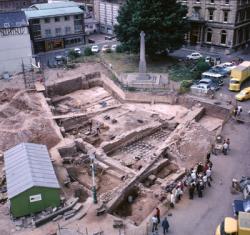 Exeter - More than 40 years after they were discovered the Roman baths buried under Cathedral Green could finally become a major tourist attraction under new plans being considered. The baths, discovered in 1971, have been described by experts as forming one of the "finest archaeological sites" in the country. .Mr Hassan said that in 1971, preliminary excavations had started on Cathedral Green for the construction of an underground car
Exeter - More than 40 years after they were discovered the Roman baths buried under Cathedral Green could finally become a major tourist attraction under new plans being considered. The baths, discovered in 1971, have been described by experts as forming one of the "finest archaeological sites" in the country. .Mr Hassan said that in 1971, preliminary excavations had started on Cathedral Green for the construction of an underground car park."One of the first trenches cut revealed an Anglo-Saxon burial, which itself had been cut into a Roman floor, edged with blocks," he said. "This proved to be the remains of a large public building, later revealed as the town basilica. "Further excavations in 1972 then uncovered the large, richly decorated and well preserved Roman Caldarium, or hot room of a bath house, built around 60-65AD. "The excavations of the bath house and its associated buildings marked a turning point in the understanding of the spread of the Roman military in Britain, which had previously been thought to have only a token presence Devon and Cornwall." He said its discovery helped to identify the presence in Exeter of a Roman fortress of the Second Augusta legion from 55-75AD, which was home to around 5,000 legionaries. The bath house would have accommodated several hundred bathers at any time and was more advanced in design than most of those in Italy at the time; the bath houses in Pompeii and Herculaneum at the time of the eruption of Vesuvius in 79AD were not as large or regularly planned as the one in Exeter.
park."One of the first trenches cut revealed an Anglo-Saxon burial, which itself had been cut into a Roman floor, edged with blocks," he said. "This proved to be the remains of a large public building, later revealed as the town basilica. "Further excavations in 1972 then uncovered the large, richly decorated and well preserved Roman Caldarium, or hot room of a bath house, built around 60-65AD. "The excavations of the bath house and its associated buildings marked a turning point in the understanding of the spread of the Roman military in Britain, which had previously been thought to have only a token presence Devon and Cornwall." He said its discovery helped to identify the presence in Exeter of a Roman fortress of the Second Augusta legion from 55-75AD, which was home to around 5,000 legionaries. The bath house would have accommodated several hundred bathers at any time and was more advanced in design than most of those in Italy at the time; the bath houses in Pompeii and Herculaneum at the time of the eruption of Vesuvius in 79AD were not as large or regularly planned as the one in Exeter.
http://www.thisisdevon.co.uk/Plans-uncover-Roman-baths/story-20045916-detail/story.html#axzz2jyfdPzrP